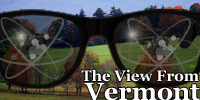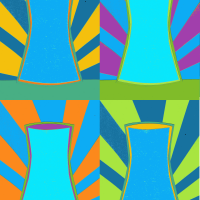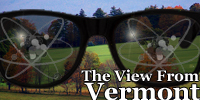A message from Goodway Technologies
Ensuring Safety and Cleanliness: The Crucial Role of Industrial Vacuums in Nuclear Power Facilities

A message from Goodway Technologies
Ensuring Safety and Cleanliness: The Crucial Role of Industrial Vacuums in Nuclear Power Facilities
Editor: Dan Yurman
 It's the Dog Days of Summer (at least by some definitions).
It's the Dog Days of Summer (at least by some definitions).
The American Nuclear Society's Board of Directors on June 30 during the ANS Annual Conference in Hollywood, Fla., approved the creation of three new student sections:
During the past few days, I have been blessed with the opportunity to eavesdrop on an intriguing e-mail exchange involving Ted Rockwell, one of my technical heroes. Rockwell is a man whose involvement in nuclear technology dates back to the Manhattan Project, where he served as a member of a "Tiger Team" of young engineers who were assigned the task of making process improvements at Y-12.
A report by a Nuclear Regulatory Commission staff task force calls for sweeping regulatory change, but also acknowledges that information about the Fukushima accident is unavailable, unreliable, or ambiguous. What should be the response in the United States to the events in Japan?
Two British environmental writers who were bitterly opposed to nuclear energy development just a few years ago decided to do some homework. Their questioning attitude and fact seeking minds have led them to the inescapable conclusion that most of the arguments against nuclear energy repeatedly offered by the opposition have been pure fabrications. George Monbiot and Mark Lynas both bring assets to the battle for hearts and minds in the energy source debate that are hard to match - they are recent converts to a pro-nuclear technology position with deep credentials in the environmental community. In addition, they are professional communicators with stories to tell.
In new media and old, time must be devoted to finding and conveying accurate information, no matter how short the news cycle.
As President-Elect of the American Nuclear Society, I welcome my fellow ANS members and non-members to the 2011 June conference!
The history of the development of peaceful uses of nuclear energy is accentuated by a number of significant emotional events. Some have been distinctly positive; the first man-made self-sustaining fission reaction, the first electricity generated by atomic energy, feats accomplished by the first nuclear powered naval vessels, the invention of life-saving nuclear medicine techniques, etc. During and following each of these milestones our collective understanding of the technology has continued to evolve and mature with increased knowledge and experience.
 As an artist I have been lucky to find a place in the nuclear community, but I haven't forgotten what it feels like to be confused about energy (there was a time when I thought that biofuels and solar panels were a viable solution). I want to describe a situation that many young Americans are facing right now, in order to offer perspective on what energy issues look like from the outside. Do your best to put yourself in someone else's shoes for a moment:
As an artist I have been lucky to find a place in the nuclear community, but I haven't forgotten what it feels like to be confused about energy (there was a time when I thought that biofuels and solar panels were a viable solution). I want to describe a situation that many young Americans are facing right now, in order to offer perspective on what energy issues look like from the outside. Do your best to put yourself in someone else's shoes for a moment:
Many American Nuclear Society members and groups across the United States have been energetically involved in the media, in their communities, and on campus during the recent events at the Fukushima plant. These members and groups have provided their knowledge and expertise to improve the accuracy of public discussions about the Fukushima events during a time when it has been sorely needed. This effort continues around the country as ANS members provide accurate, scientifically-sound information in front of TV cameras, at campus symposia, on local radio, in newspapers and journals, and by many other ways.
Now that the recent events at the nuclear plants at Fukushima are largely behind us and the stabilization is underway, we look to the 25th anniversary of Chernobyl and recognize that comparisons are inevitable. But it's vital that we keep these events in perspective as we face the challenges of developing our energy resources for our global future.
On Wednesday, April 6, Dr. Michael Corradini is appearing on behalf of the American Nuclear Society before the U.S. House Energy and Commerce Subcommittee on Oversight and Investigations.
There are many facets of my chosen avocation as a pro-nuclear blogger and podcaster, but one aspect that has been prominent during the 25 days since the Japanese earthquake, tsunami, and nuclear nightmare at Fukushima has been that of atomic educator. Following the role model of my favorite teachers, I have worked hard to maintain a two-way flow of information-successful educators have to be open-minded learners. There is no doubt that I know a lot more about the design and operation of boiling water reactors with MK I containment vessels now than I knew four weeks ago.
In my previous post for the ANS Nuclear Cafe, I described what I had learned from debating nuclear opponents.
 I was not born a geek, but by the time I was a 10-year-old buying books at the Museum of Science and Industry in Chicago, my path was set. Some considered this as an unfortunate background, so I had to learn the hard way how to handle myself in debates and how to answer aggressive questions. Below, I share what I have learned in defending my position, in the hope that it will help others.
I was not born a geek, but by the time I was a 10-year-old buying books at the Museum of Science and Industry in Chicago, my path was set. Some considered this as an unfortunate background, so I had to learn the hard way how to handle myself in debates and how to answer aggressive questions. Below, I share what I have learned in defending my position, in the hope that it will help others.
The views expressed in this article are the author's, and do not represent the editorial position of Nuclear News magazine or the policy of the American Nuclear Society.
A few months ago, I had the honor of leading a class of future engineering leaders at Iowa State University. The dean, Dr. Jonathan Wickert, occasionally asks alums and others who have done interesting things with their engineering degrees to come in and lead the class in a case study. Events in the Gulf of Mexico that started in April 2010 with the Macondo oil spill provided an excellent opportunity to talk about crisis management and communications, with the added benefit of current technology relevance. This is an area that the nuclear industry also needs to study and understand.